Hack16.Amplify Your PSP
Hack 16. Amplify Your PSP
Want to bring the noise with your PSP, but your speakers don't quite manage the bump that you need? Time to learn the basics of audio amplification and apply them. The speakers on the PSP are okay, as are the headphones, but wouldn't you like a little bit more oomph to your audio? Sure, you could spend some money and buy a nice audio amplifier, but wouldn't it be more fun to build your own? This hack walks you through putting together a very basic audio amp for your PSP. Since I'm using a solderless breadboard to make all the connections clear, this isn't a permanent solution. However, if you can follow along with these instructions to get the amp up and running, it won't be that difficult to purchase a small circuit board and, with some careful soldering, put together a smaller version of this that could easily be shoved into a rather small container (such as an Altoids tin [Hack #13]). Once you've tested the waters with this hack, a quick Google search will turn up various other audio amp instructions that have materialized online, such as the CMoy Pocket Amplifier HowTo (http://tangentsoft.net/audio/cmoy-tutorial/). Most of these instructions tout themselves as beginner DIY projects, but still have a learning curve that will scare away some beginners. This hack will avoid the shock factor and ease you slowly into the world of audio DIY. 2.6.1. Things You'll NeedBefore you get started, make sure you have all these components handy:
2.6.2. Assemble the CircuitIf you are familiar with circuit diagrams, then you can refer to Figure 2-41 as you work on this basic amplifier. Figure 2-41. Diagram of the circuit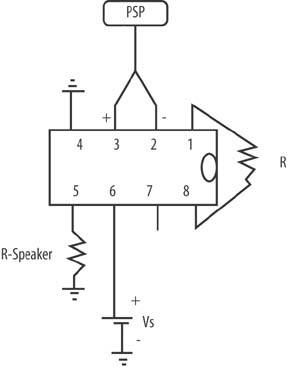 The first step is to place the audio amp chip in the breadboard and designate a line for ground, as shown in Figure 2-42.
Locate the notch on one end of the chip and make sure the notch is facing to the right. The pins on the chip number around the chip, starting from the top right near the notch, which is pin 1, and going around the chip in a C-shape to come back to the bottom right near the notch, which is pin 8. If you consult the diagram on the back of the box the chip came in, you will know the purpose for each pin. On this particular chip (RadioShack part #LM386), pins 1 and 8 are gain pins, pin 2 is negative audio input and pin 3 is positive audio input, pin 4 is ground, pin 5 is audio output, pin 6 is the Vs or voltage source pin, and pin 7 is the bypass pin. Figure 2-42. Circuit with ground pin wired to ground on the breadboard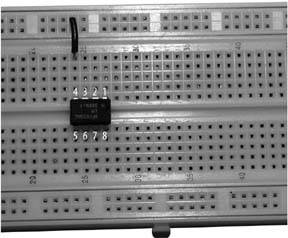 Connect the ground pin (pin 4) to the line you previously designated for ground. Put the wire that will serve as the audio input from the PSP into the proper pins of the audio amp chip (pins 2 and 3, negative and positive respectively; these appear as the two wires to the right of the ground wire above the chip in Figure 2-43). Connect the positive wire from the voltage source into the Vs pin (pin 6) of the audio amp chip (the wire on the bottom right in Figure 2-43). Connect the negative speaker terminal to ground (this is the top wire coming from off the board in Figure 2-43). Connect the positive speaker terminal to the output of the audio amp chip (this is the bottom wire attached to pin 5, coming from off the board in Figure 2-43). Now you have the completed setup for the circuit. If you bought a bare speaker sans wires, make sure that the two wires are soldered correctly onto the speaker. Attach the negative and positive alligator clips from the audio input cable to the two audio input wires you have connected to pins 2 and 3.
Figure 2-43. Wiring the chip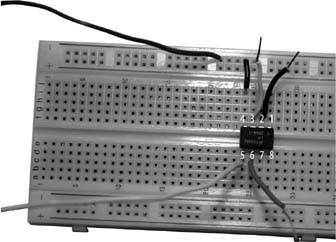 Once everything is in place, it's time to add the power. For this hack, I used the same battery holder that I used in "Make a Battery Pack for Your PSP" [Hack #15] as the power source for the amp. The chip can handle voltage from roughly 415 volts, but it's better to keep the voltage closer to 5 volts, since the chip tends to run hot and can easily burn out. Attach the negative wire from your battery pack to ground, and attach the positive wire to the voltage source wire connected to the Vs pin to turn it on (Figure 2-44). Figure 2-44. Everything properly connected with a resistor in place to increase the gain, and a heat sink clamped onto the chip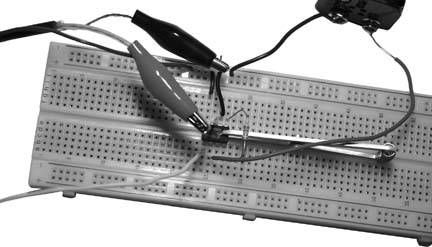 2.6.3. Test the AmpAfter all your connections are made, plug the audio cable into your PSP and start up something with audio at a moderate volume level (to ensure that you don't blow the speaker). Since you're using a single speaker, the audio will be coming out in mono, but it will be noticeably louder than the PSP alone. As you increase the volume, you will notice that there is an increase in distortion. If you hear nothing, check all your connections again. 2.6.4. Problems and Easy ImprovementsThe sound quality of this particular amp won't be amazing because I used rather cheap parts. Using better parts, especially a better quality 8-ohm speaker, would improve the sound quality. This setup is also reliant on the inexpensive audio chip used, which has a tendency to occasionally overheat and can even burn out if left running for too long. Using a more powerful and more expensive amplifier chip in the design would result in a better amp. Simply adding a heat sink will help prevent the current chip from burning out as quickly. Adding a capacitor between the output pin of the chip and the speaker's positive terminal will essentially create a "high pass filter" and cut down on distortion and noise from the power supply by blocking lower frequency signals. There's also no on and off switch. The design currently works by connecting or disconnecting the power. Adding a switch in between the Vs pin wire and the positive wire from the battery pack would give you the ability to turn this amplifier on or off. 2.6.5. Hacking the HackAfter successfully building this very basic audio amplifier for your PSP, you should be ready to tackle a slightly more complex project. As you can see in Figure 2-45, the size and portability of the completed project isn't very useful. Redesigning this amplifier on a smaller circuit board, you could easily fit the entire circuit inside a very small container for protection and portability. Rather than hardwiring the connections to an audio line to the PSP and the speaker, you could attach a female audio port to both the input and output for the audio, using a male-to-male cord to pull the input from the PSP and running a cord to your headphones or any speaker you have from the other output port. If you really want to hack this hack, build a new and better amplifier to include as part of "Portable PSP Speakers" [Hack #31]. Figure 2-45. The completed project with a capacitor added to help reduce the distortion as the volume is increased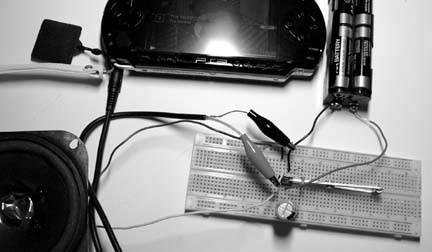 |
EAN: 2147483647
Pages: 108
